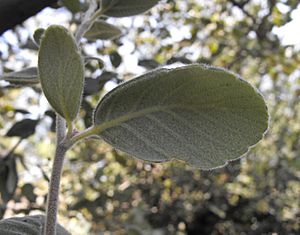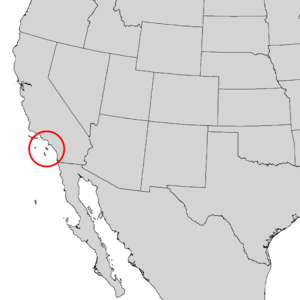Santa Catalina Island mountain-mahogany facts for kids
Quick facts for kids Santa Catalina Island mountain-mahogany |
|
|---|---|
 |
|
| Conservation status | |
| Scientific classification | |
| Genus: |
Cercocarpus
|
| Species: |
traskiae
|
 |
|
| Natural range of Cercocarpus traskiae | |
Cercocarpus traskiae, also known as the Santa Catalina Island mountain-mahogany or Catalina mahogany, is a very rare plant. It belongs to the rose family. This special plant is found only on Catalina Island in California.
Contents
Where It Lives
This plant is found only in one place: Catalina Island. This island is one of the southern Channel Islands off the coast of Los Angeles County, California. It grows in just one spot called Wild Boar Gully. This gully is a small canyon covered in coastal sage scrub plants. The sides of the gully are steep and have a special type of soil.
When this plant was first found by Blanche Trask in 1897 or 1898, there were only about 40 to 50 plants. It was already very rare back then. By 1996, when it was listed as an endangered species by the government, only six mature plants were left. People have called it "one of the rarest shrubs" and "one of the rarest trees" in North America.
What It Looks Like
The Cercocarpus traskiae is a large shrub or a small tree. It can grow up to 8 meters (about 26 feet) tall. Its leaves are thick and leathery. They are oval-shaped with jagged edges. The underside of the leaves feels woolly and hairy. This woolly texture helps tell it apart from other similar plants.
The plant's flowers grow in a cluster, with up to 10 flowers together. These flowers do not have petals. The plant does not always produce flowers every year.
Plant Reproduction and Survival
Even though many young plants, called seedlings, sometimes appear, not many of them survive. It's hard for new plants to grow into adults. As of 2007, there were only seven adult trees that could make seeds. All of these trees are in Wild Boar Gully, and most of them are very old.
Protecting This Rare Plant
The Catalina Island mountain-mahogany faces threats from animals like deer, feral goats, and pigs. These animals eat or damage the plants. Luckily, the goats have been removed from the island. Fences have also been put up to stop other animals from reaching the plants.
This rare plant can also mix its genes with a related plant called Cercocarpus betuloides. This is called hybridizing. When this happens too much, the unique traits of the rare plant might get lost. This mixing of genes might happen more easily when animals disturb the plant's home. Many of the young plants growing today might actually be these mixed-gene plants.
The number of pure Cercocarpus traskiae plants is not growing on its own. This means the plant needs help from people to survive today.
See also



